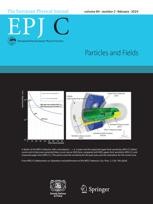Placing cosmological constraints on quantum gravity phenomenology
Researchers have used cosmological data to place stringent new limits on a model which emerges in attempts to reconcile gravity with the principles of quantum mechanics.
New York | Heidelberg, 9 February 2021
 A description of gravity compatible with the principles of quantum mechanics has long been a widely pursued goal in physics. Existing theories of this ‘quantum gravity’ often involve mathematical corrections to Heisenberg’s Uncertainty Principle (HUP), which quantifies the inherent limits in the accuracy of any quantum measurement. These corrections arise when gravitational interactions are considered, leading to a ‘Generalized Uncertainty Principle’ (GUP). Two specific GUP models are often used: the first modifies the HUP with a linear correction, while the second introduces a quadratic one. Through new research published in EPJ C, Serena Giardino and Vincenzo Salzano at the University of Szczecin in Poland have used well-established cosmological observations to place tighter constraints on the quadratic model, while discrediting the linear model.
A description of gravity compatible with the principles of quantum mechanics has long been a widely pursued goal in physics. Existing theories of this ‘quantum gravity’ often involve mathematical corrections to Heisenberg’s Uncertainty Principle (HUP), which quantifies the inherent limits in the accuracy of any quantum measurement. These corrections arise when gravitational interactions are considered, leading to a ‘Generalized Uncertainty Principle’ (GUP). Two specific GUP models are often used: the first modifies the HUP with a linear correction, while the second introduces a quadratic one. Through new research published in EPJ C, Serena Giardino and Vincenzo Salzano at the University of Szczecin in Poland have used well-established cosmological observations to place tighter constraints on the quadratic model, while discrediting the linear model.
The GUP can influence the black hole evaporation process first described by Stephen Hawking, and may also lead to better understanding of the relationship between thermodynamics and gravity. Intriguingly, the GUP also places a lower limit on length scales that are possible to probe – below the so-called ‘Planck length,’ any concentration of energy would collapse under gravity to form a black hole. Previously, both the linear and quadratic GUP models were rigorously tested by comparing their predictions with data gathered in quantum experiments, placing stringent limits on their parameters.
In their study, Giardino and Salzano instead compared the predictions of GUP-influenced models of the universe with observations of cosmological phenomena, including supernovae and cosmic microwave background radiation. These comparisons were not widely made in the past, since the constraints they imposed on the GUP parameters were believed to be far weaker than those possible in quantum experiments. However, the researchers’ analysis revealed that stricter bounds could be imposed on the quadratic model, comparable to those placed by some quantum experiments. In addition, they showed that the linear correction to the HUP generally could not account for the observed data. Ultimately, these results highlight the promising role of cosmological observations in constraining the phenomenology of quantum gravity.
References: S Giardino, V Salzano (2021), Cosmological constraints on GUP from modified Friedmann equations, European Physical Journal C 81:110, DOI 10.1140/epjc/s10052-021-08914-2
Further Information
For more information visit: www.epj.org
Services for Journalists
The full-text article is available open access here.
Contact
Sabine Lehr | Springer | Physics Editorial Department
tel +49-6221-487-8336 | sabine.lehr@springer.com
